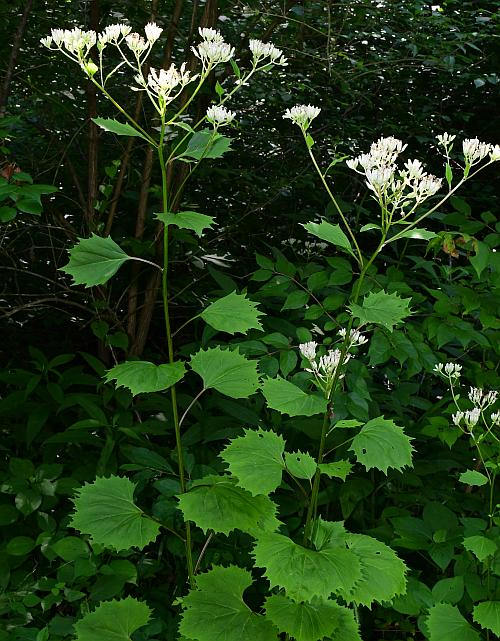Arnoglossum reniforme (Hook.) H. Rob.
Great Indian Plantain

Native
CC = 8
CW = 5
MOC = 42
© SRTurner
Arnoglossum reniforme (Hook.) H. Rob.Great Indian Plantain | |
 |
Native CC = 8 CW = 5 MOC = 42 |
© SRTurner |
|
Family - Asteraceae/Senecioneae Habit - Perennial forb, on fleshy rootstock. Stems - Erect, to 3 m, glabrous, not glaucous, usually unbranched below the inflorescence, with longitudinal angles and grooves, hollow.
Leaves - Basal and alternate, simple, herbaceous in texture, mostly glabrous, green above, lighter but not glaucous below. Petioles grooved adaxially, with reddish margins along the groove. Basal and lower leaves long-petiolate, the blades to 65 cm long, broadly triangular-ovate to kidney-shaped, sometimes shallowly palmately lobed, the tip and lobes rounded or very bluntly pointed, usually broadly cordate at the base, the margins otherwise irregularly toothed, the venation palmate with mostly 7-10 main veins, the undersurface not or only slightly glaucous. Upper leaves reduced, short-petiolate, often truncate, otherwise similar.
Inflorescence - Terminal and axillary panicles, usually flat-topped, the peduncles whitened, glabrous. Each inflorescence branch subtended by a minute bract. Bracts subulate, white, 1-5 mm long.
Heads - Involucre 7-9 mm long, cylindrical, the inner 5 bracts rounded dorsally, uniformly greenish white, sometimes darker along the margins, glabrous, the outer series usually absent (rarely with 1 or 2 minute bracts toward the tip of the stalk of the head). Heads typically with 5 disk florets. Flowers - Ray florets absent. Disk corollas 7-10 mm long, glabrous, white or cream-colored, 5-lobed. Corolla lobes white, curled, to 3 mm long, 1 mm broad, acute. Stamens 5, adnate at the base of the campanulate portion of the corolla tube. Filaments filiform, yellowish-tan, glabrous. Anthers tan-brown, 2 mm long, connate around the style, exserted. Style exserted beyond the anthers, glabrous, white, bifurcate. Pappus of white capillary bristles to 7 mm long.
Fruits - Achenes green and glabrous in flower, cylindric, to 3 mm long. Flowering - May - September. Habitat - Rich woods, north or east-facing slopes, ravines, bluffs along streams. Origin - Native to the U.S. Lookalikes - A. atriplicifolium. Other info. - This striking species can be found mainly in the eastern half of the state as well as much of the American Midwest. The plant is easy to ID in the field, and easily distinguished from the other Indian plantains in Missouri, having leaves which are neither leathery nor glaucous underneath. The leaves are typically "reniform" in shape - indented at the base and a little wider than long. The plant is most often encountered as just basal rosettes because it takes about 2-3 years to bloom for the first time. It grows well from seed and would make a fine plant in cultivation. Robust plants are quite showy when in bloom. Individual flowers have no visible petals, but the large, strongly whitened inflorescences are attractive. Photographs taken at Alley Spring, Shannon County, MO., 6-27-03 (DETenaglia); also at Shaw Nature Reserve, Franklin County, MO, 6-27-2008, Young Conservation Area, Jefferson County, MO, 4-15-2020, and Weldon Spring Conservation Area, St. Charles County, MO, 6-19-2009 and 6-6-2020 (SRTurner). |